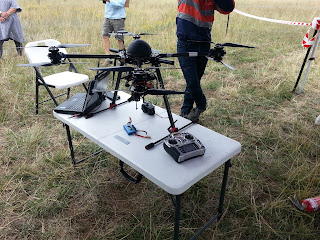I have a acquaintances who argue that global warming isn't happening, but just have a look at these figures for my home town, Armidale. For the record, my home is at roughly 1000 m above sea level (or 3250 feet). And, because of our relatively low latitude (roughly 30 degrees South or similar to Cairo, which is 30 N!, our average January daily maximum is about 26.8 C (>80 F).
That's nice, but have a look at 2017's figures. This year we've averaged so far 29.2 (or nearly 85 F) and the forecast for the next 7 days is impressive: 27-28-30-31-32-33-34. This will raise the average figure for this month to 29.3! That's way above average and the hottest on record, with that being 28.7 C in 2003.
But what's happening during the day is mirrored at night. Our long term average minimum is 12.7 (55 F), but that has soared in 2017 to 15.9 (60.6 F). No wonder I've taken to riding my bike at c. 6.30 am when it's nice and cool, but not cold. And I've therefore upped my daily daily distance to an average of 15 km a day or about 105 km a week (or 65 miles). Hey, that's an interesting number! That's rather further than riding from Poole (Dorset) to Seaton (Devon) or about the same as going from (Plympton (Devon) to Falmouth (Cornwall) or a little less than pedalling from Kirkland to Olympia (for my US readers in the Pacific NW)
And while I'm on our weather, I might mention that our monthly total rain is about 85.4 mm (3.4 inches), but this year so far we've only received 45.2 mm (1.8 inches) with only 6 days to go. So, the combination of heat and lack of rain has browned off patches of our lawn. I tried to remedy that with watering from sprinklers, but fortunately the last two days have seen some heavy thunderstorms dump about 25 mm of that 45+ mm over that period. And more is forecast for today - likely given the heavy cloud hanging around. Welcome though the rain is, the last two days have been a bit like living in a sauna!
Sorry, I can't take a selfie of me riding my bike!
AS
That's nice, but have a look at 2017's figures. This year we've averaged so far 29.2 (or nearly 85 F) and the forecast for the next 7 days is impressive: 27-28-30-31-32-33-34. This will raise the average figure for this month to 29.3! That's way above average and the hottest on record, with that being 28.7 C in 2003.
But what's happening during the day is mirrored at night. Our long term average minimum is 12.7 (55 F), but that has soared in 2017 to 15.9 (60.6 F). No wonder I've taken to riding my bike at c. 6.30 am when it's nice and cool, but not cold. And I've therefore upped my daily daily distance to an average of 15 km a day or about 105 km a week (or 65 miles). Hey, that's an interesting number! That's rather further than riding from Poole (Dorset) to Seaton (Devon) or about the same as going from (Plympton (Devon) to Falmouth (Cornwall) or a little less than pedalling from Kirkland to Olympia (for my US readers in the Pacific NW)
And while I'm on our weather, I might mention that our monthly total rain is about 85.4 mm (3.4 inches), but this year so far we've only received 45.2 mm (1.8 inches) with only 6 days to go. So, the combination of heat and lack of rain has browned off patches of our lawn. I tried to remedy that with watering from sprinklers, but fortunately the last two days have seen some heavy thunderstorms dump about 25 mm of that 45+ mm over that period. And more is forecast for today - likely given the heavy cloud hanging around. Welcome though the rain is, the last two days have been a bit like living in a sauna!
Sorry, I can't take a selfie of me riding my bike!
AS



























































